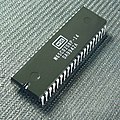computer science, read–modify–write is a class of atomic operations (such as test-and-set, fetch-and-add, and compare-and-swap) that both read a memory location...
2 KB (545 words) - 06:55, 23 March 2025
than the read–erase–modify–write process needed for randomly written data going through garbage collection. The peak random write performance on an SSD...
45 KB (4,749 words) - 14:25, 13 May 2025
&\end{bmatrix}}} T2 could read a database object A, modified by T1 which hasn't committed. This is a dirty or inconsistent read. T1 may write some value into A...
2 KB (249 words) - 18:06, 28 May 2025
Random-access machine (section Register-to-register ("read-modify-write") model of Cook and Reckhow (1973))
arithmetic "operation", in particular with respect to what are called 'read-modify-write' instructions such as "Increment indirectly the contents of the register...
66 KB (7,515 words) - 15:56, 20 December 2024
extended to 2 GiB, also added a read-modify-write cycle (RMC) pin, indicating that an indivisible read-modify-write cycle in progress, in order to help...
7 KB (762 words) - 06:25, 3 April 2025
since the load-link. Together, this implements a lock-free, atomic, read-modify-write operation. "Load-linked" is also known as load-link, load-reserved...
13 KB (1,427 words) - 05:42, 22 May 2025
allows a write to be seen earlier than a read's completion. A combination of read modify write operations may be required to make an illusion of write atomicity...
57 KB (7,554 words) - 14:11, 31 October 2024
When modifying less than a stripe of data, RAID 5 and 6 requires the use of read-modify-write (RMW) or reconstruct-write (RCW) to reduce a small-write penalty...
40 KB (4,552 words) - 18:14, 17 June 2025
Those that do not can still implement an atomic test-and-set using a read-modify-write or compare-and-swap instruction. The test and set instruction, when...
15 KB (2,179 words) - 20:20, 1 April 2025
of the ultracomputer project, he was one of the inventors of the read–modify–write concept in parallel and distributed computing. He is an associate...
5 KB (526 words) - 03:46, 13 June 2022
difficult to write lock-free code that is correct. Non-blocking algorithms generally involve a series of read, read-modify-write, and write instructions...
19 KB (2,385 words) - 18:21, 5 November 2024
File-system permissions (redirect from Read/write rights)
but not to read other information about them such as contents, file type, size, ownership, permissions. Write grants the ability to modify a file. When...
19 KB (2,011 words) - 10:39, 5 May 2025
continue accessing the old versions and can dispense with the atomic read-modify-write instructions, memory barriers, and cache misses that are so expensive...
43 KB (5,080 words) - 00:54, 6 June 2025
Readers–writer lock (redirect from Read write lock pattern)
locked in read-mode to write-mode, as well as being downgraded from write-mode to read-mode. [1] Upgrading a lock from read-mode to write-mode is prone...
14 KB (1,471 words) - 15:04, 27 January 2025
the value stored. Other types of shared data structures include read–modify–write, test-and-set, compare-and-swap etc. The memory location which is concurrently...
10 KB (1,064 words) - 04:29, 29 September 2024
Write once read many (WORM) describes a data storage device in which information, once written, cannot be modified. This write protection affords the assurance...
8 KB (1,004 words) - 00:23, 25 May 2025
discard the copy. Copy-on-write can be implemented efficiently using the page table by marking certain pages of memory as read-only and keeping a count...
10 KB (982 words) - 15:02, 17 May 2025
implemented externally by the use of an RMC pin to indicate an indivisible read-modify-write cycle in progress. All other processors have to hold off memory accesses...
28 KB (2,925 words) - 23:53, 27 February 2025
the effort. Atomic transaction Consistency model ACID Read-copy-update (RCU) Read-modify-write Time of check to time of use Herlihy, Maurice P.; Wing...
24 KB (3,291 words) - 10:59, 7 February 2025
WDC 65C02 (section New and modified instructions)
addressed. Memory lock (MLB) output indicates to other bus masters when a read-modify-write instruction is being processed. WAit-for-Interrupt (WAI) and SToP...
37 KB (4,396 words) - 03:55, 18 June 2025
Each transaction involves a read (A or B), and a write (C). The only conflict between these transactions is the write on C. The following is one possible...
3 KB (519 words) - 22:58, 20 March 2023
read-of-non-persistent-write problem. Conditional Put and Delete Fetch-and-add Load-link/store-conditional Non-blocking synchronization Read–modify–write...
19 KB (2,529 words) - 05:05, 28 May 2025
of 2019, with small-write latency. As the memory was inherently fast, and byte-addressable, techniques such as read-modify-write and caching used to enhance...
22 KB (2,168 words) - 06:50, 27 May 2025
uses the old value of the variable, not the current value. Atomic read-modify-write solves this problem. Modern C++ offers atomic variables and operations...
17 KB (2,183 words) - 06:27, 8 April 2025
processor does an extra read of the last instruction byte. The 6502 read–modify–write instructions perform one read and two write cycles. First, the unmodified...
118 KB (11,764 words) - 02:32, 12 June 2025
read file write get edit resource initialize memory modify PLC-2 compatibility file open file physical read physical write read bytes physical read diagnostic...
2 KB (174 words) - 20:51, 26 September 2024
Hazard (computer architecture) (redirect from Read after write (Hazard))
used to resolve data hazards: insert a pipeline bubble whenever a read after write (RAW) dependency is encountered, guaranteed to increase latency, or...
10 KB (1,237 words) - 10:14, 13 February 2025
algorithm is that it doesn't require special test-and-set (atomic read/modify/write) instructions and is therefore highly portable between languages and...
8 KB (1,063 words) - 07:14, 9 June 2025
released.: Chapter 8 The second group of atomic instructions perform read-modify-write sequences: a load (which is optionally a load-acquire) to a destination...
154 KB (15,964 words) - 13:28, 16 June 2025
that, except in sections of code that are synchronized, only atomic read-modify-write instructions should be used in these variables (it should not be possible...
18 KB (2,041 words) - 05:43, 19 May 2025








